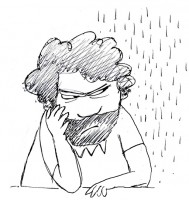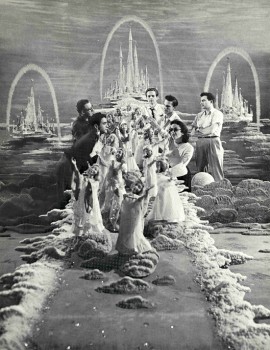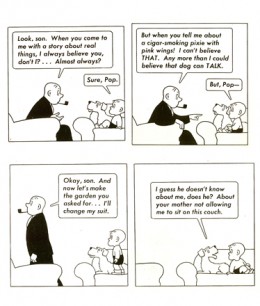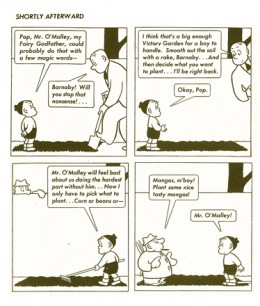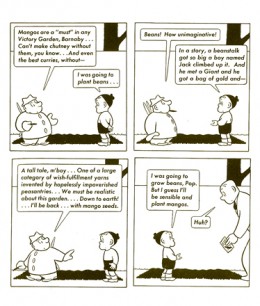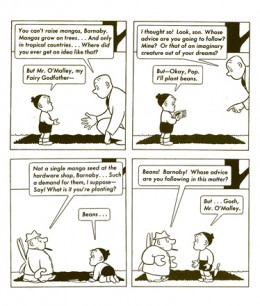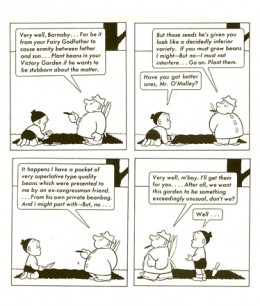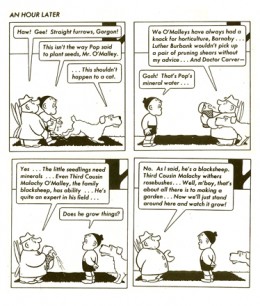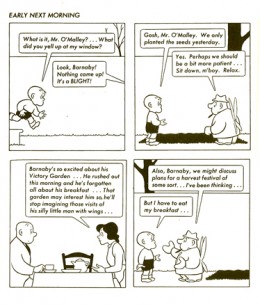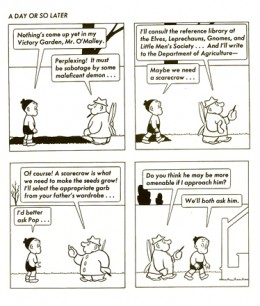Monthly ArchiveJune 2006
Animation Artifacts &Fleischer 11 Jun 2006 07:40 am
Hoppity Songs
– Finishing off my short series on sheet music, for now, I have a non-Disney cover. It’s the 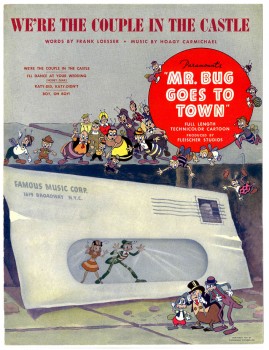 sheet music for the 2nd feature film from the Fleischer’s, Mr. Bug Goes To Town.
sheet music for the 2nd feature film from the Fleischer’s, Mr. Bug Goes To Town.
This was a feature that really got me going when I was young. I think it was the first original story done in animation; not an adapted fairy tale or novel. The story still works for me, though it comes off as a bit episodic. (Actually, I think most animated features are too episodic.) They’ve created a complete world for these insects, and it works.
Technically the film is a bit limited. The opening title shot is a stunning shot panning down the Empire State Building and across NYC ending on the vacant lot where the bugs live. The animation is adequate for the period; it has a charm that I find delightful and sometimes exciting. The voices are good, and the music is excellent.
(Click images to enlarge.)
This was the hit song, written by the brilliant Hoagy Carmichael (who wrote Stardust, Heart and Soul, and Skylark) and the just-as-brilliant Frank Loesser (who wrote Guys and Dolls, Hans Christian Andersen, and How To Succeed In Business). The score for the film was co-written by Leigh Harline (who scored Pinocchio, a lot of Disney shorts, and The 7 Faces of Dr. Lao, among others).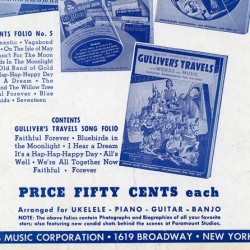
As we’ve seen with the last two postings, most sheet music was printed with one or two colors )red for Der Fuehrer’s Face, brown & green for Song of the South) as opposed to full color. However, this Fleischer song has a full color cover (although they use one color on the rear cover). It shows that Paramount felt they had a hit song here, and they did have a modest hit. Glenn Miller’s recording of it didn’t hurt.
The rear cover is little more than an ad for other Paramount songs. However, in among the group is Gulliver’s Travels. I’m posting just this small section of the back cover, printed in blue.
Festivals 10 Jun 2006 05:49 pm
Annecy 2006 Winners
Regina Pessoa‘s Tragic Story with Happy Ending and Joanna Quinn‘s Dreams and Desires – Family Ties seem to be the big award winners at the Annecy Animation Festival.
These are all of the awards given last night in Annecy:
Short films
Histoire tragique avec fin heureuse (The Annecy Cristal) France
Rabbit (Special distinction) United Kingdom
One D (Jr Jury Award for a short film) Canada
Dreams and Desires – Family Ties (Audience award) United Kingdom
Dreams and Desires – Family Ties (FIPRESCI award) United Kingdom
Delivery (Xiberras award for a first film) Germany
Dreams and Desires – Family Ties (Jury’s special award) United Kingdom
Histoire tragique avec fin heureuse (TPS Cinceculte Award for short film) France
Cherno na byalo (Unicef award) Bulgaria
Feature films
Renaissance (The Cristal for best feature) France
TV series
Pocoyo “A Little Something Between Friends” (The Cristal Best TV production) Spain
Zombie Hotel “First Day” (Special award for a TV series) France
TV specials
Petit Wang (TV special award) France
Educational, scientific or industrial films
The Birds & The Bees – A Secret You Shouldn’t Keep (Educational film award) Korea
Advertising films
Médecins sans frontières “Human Ball” (Advertising film award) Belgium
Music video
Thomas Fersen “Hyacinthe” (Award for best music video) France
Graduation films
Abigail (Special distinction) United Kingdom
Ego (Jr Jury Award for a graduation film) France
Astronauts (Best school or graduation film) United Kingdom
Walking in the Rainy Day (Jury award for a graduation film) Korea
Animation Artifacts 10 Jun 2006 07:59 am
Song of the South Music
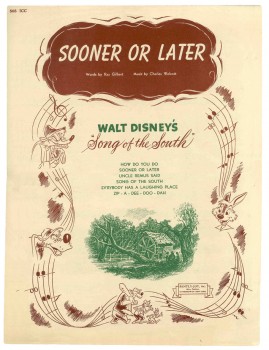
- To continue with the graphics on sheet music, the music for Song of The South, in the 1940′s wasn’t quite as dynamic as the one I posted yesterday, Der Fuehrer’s Face.
This cover tries to capture the lyrical, romantic feel of the film. Here surrounding the live-action plantation, with all the different songtitles available from the film in the sky, is a border consisting of the animated characters from the film. The colors are limited to the green-etched homestead and the brown-linear characters.
The back cover of the sheet music contains a shot of the live-action characters, James Baskett, Bobby Driscoll, and Luana Patten. All are colored in the same brown ink as the cover’s line art.
(Click on images to enlarge.)
That year “Zip-A-Dee-Doo-Dah“, also from this film, won the Oscar, while the music, itself, was nominated for Best Scoring of a Musical Picture.
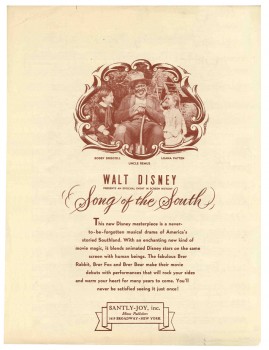 This film made quite an impression on me when I was a kid. And this song was one of the two I played over and over from the record. I also loved “Laughing Place”. It’s something of a shame that the film has been kept out of circulation in the US. I can’t imagine that the film affected me as a child in any negative way. Uncle Remus was clearly the hero of the film and the only truly positive adult character in the film.
This film made quite an impression on me when I was a kid. And this song was one of the two I played over and over from the record. I also loved “Laughing Place”. It’s something of a shame that the film has been kept out of circulation in the US. I can’t imagine that the film affected me as a child in any negative way. Uncle Remus was clearly the hero of the film and the only truly positive adult character in the film.
The last time I saw the film projected was back in the 70′s when Disney set themselves up at Lincoln Center to show a complete retrospective of ALL their films. At the library auditorium behind Lincoln Center there were a number of seminars in which Frank Thomas, Ollie Johnston, Ken Andersen and Woolie Reitherman talked about their work.
I remember Frank Thomas talking about this feature, saying that Disney only did the best for the film hiring the greatest cinemaphotographer, Gregg Toland, to shoot it. He’d shot everything from Citizen Kane to The Grapes of Wrath. (Both are unbelievably stunning works of cinematographic art.) What Thomas didn’t say, or didn’t realize, was that this was Toland’s first COLOR feature. And it showed. Garish, cartoon colors flooded the screen, with actors wearing much too much makeup. A big step for Toland but not the best photography.
Still, I remember those colors vividly, and I would love to see it again – on screen. A dvd would do.
Animation Artifacts 09 Jun 2006 07:06 am
Der Fuerher’s Face
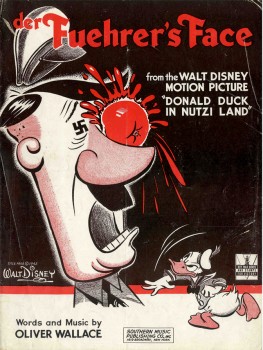 – I’ve long been a fan of old sheet music and have a tiny collection of songs from animated pictures. I’m going to post a couple of them in the next week.
– I’ve long been a fan of old sheet music and have a tiny collection of songs from animated pictures. I’m going to post a couple of them in the next week.
This is a song by Oliver Wallace in the Donald Duck cartoon, Der Fuerher’s Face. The sheet music is a bit rare in that it has the original title of the Donald film, Donald Duck In Nutzi Land.
They soon changed the title on the sheet music, especially after the music became a #1 hit in a version by Spike Jones & His City Slickers.
You can see the film on the Walt Disney Treasure DVD – On The Front Lines: Disney Goes To War.
The film deservedly won the Oscar for Best Short Subject in 1942. Its opposition were all propaganda war films.
(All images can be enlarged by clicking.) 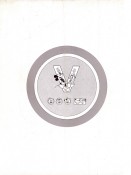
- Here’s the back page for those who want to see the Disney logo for sheet music back then.
- Continuing the musical thread, I love these musical objects found on Fwak Grab Bag (an entertaining site.)
- For those searching for CARS reviews by non-animation reviewers here are three from NYC: one glowing (NYDaily News), one mixed/negative (Village Voice), one negative (NYTimes).
Comic Art 08 Jun 2006 07:08 am
Coconino Classics
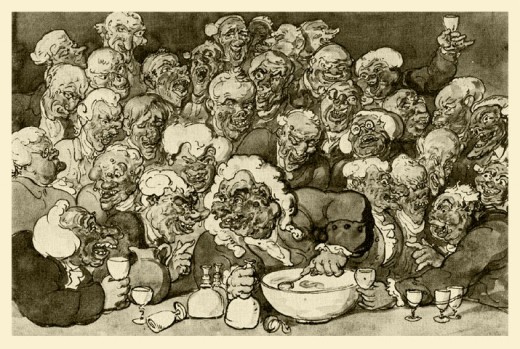
Thomas Rowlandson – “The Ugly Club”
For those who aren’t aware of this site, Coconino-Classics.com is an excellent French website which features galleries of early comic strips and illustrations. There are lots of Herriman (early Krazy Kat strips and lots of them), Cliff Sterrett, Rube Goldberg, George McManus. And lots more.
It’s a good place to spend and hour or two and comeback for more.
I was particularly entertained by William Glackens‘ panel strip, Rabbi Fleizer’s Xmas. It’s certainly an oddity and interesting. There’s something curious to me about seeing the print work of some notable artists like Glackens or Feininger or Kley or Cruikshank.
Daily post 07 Jun 2006 10:14 am
Gettingsickofrainagain
As the disk jockey on the radio called it, “the absolutely horrendous weather,” continues.
Rain. Will it get heavy enough to flood again? (I doubt it) Will the Yankees be rained out? (they’re playing some great, entertaining games against Boston) Will I get past this annoyance?(probably)
Comic Art 07 Jun 2006 07:34 am
Patrick McDonnell
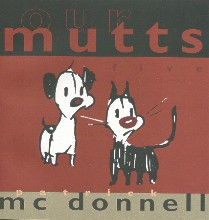 - I love the artwork of Patrick McDonell. His Mutts comic strip is oftentimes as good as many of the brilliant strips of the past. Just look at this watercolor comic on-line, and see how well it compares to any of those beautiful Polly and Her Pals strips I’ve posted in the past. HERE or HERE
- I love the artwork of Patrick McDonell. His Mutts comic strip is oftentimes as good as many of the brilliant strips of the past. Just look at this watercolor comic on-line, and see how well it compares to any of those beautiful Polly and Her Pals strips I’ve posted in the past. HERE or HERE
There’s a joy in the drawing of McConnell’s strip that just comes across on the printed page. On his site he features Watercolor Sundays on which he posts actual watercolors rather than the airbrushed/Photoshop look most of the published colored strips feature. Somehow the watercolor look is especially becoming in this style.
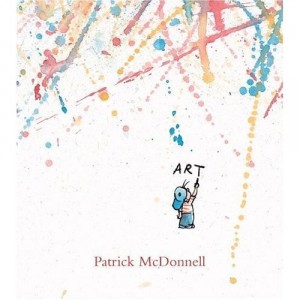 - Patrick also has a new book available. Art was released this year and is a beauty. Take a look at it next time you’re near the children’s book section of your favorite book store, or else just buy it on Amazon.
- Patrick also has a new book available. Art was released this year and is a beauty. Take a look at it next time you’re near the children’s book section of your favorite book store, or else just buy it on Amazon.
The selling point the marketers are using is to compare it to Crockett Johnson‘s Harold and The Purple Crayon. The art of this book is much more lively and free than Johnson’s quiet, tight style. Both are distinctive yet wildly different. Thematically, I suppose they’re similar, but Patrick McDonnell’s “Art” is significantly more vibrant.
Animation Artifacts &Puppet Animation 06 Jun 2006 07:07 am
Hansel & Gretel
- Hansel and Gretel was an animated feature produced in 1954 by Michael Myerberg a showman of a producer who made elaborate claims for his sets and puppets and pushed the publicity to feature many innovations that didn’t exist. 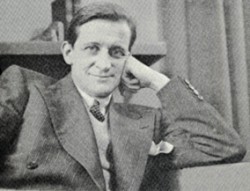
I can remember CBS covering the film’s premiere. They had the upper half of the puppet of Rosina Rubylips in a glass box – it looked not unlike the gypsy fortuneteller in the movie BIG. Supposedly the puppets were controlled by electronics. Singer Anna Russell, at the premiere, was prompted to turn dials, and the puppet moved in a robotic movement. The film employed animation. There were no electronics operating the puppets; there were wires.
(producer Michael Myerberg)
As a child, I was intrigued with this puppet feature – a rarity in those days – and searched for any information about the production. A magazine I have, Closeup #2 (1976) offered a lot of photos of this film, and I thought I’d post some of them.
The feature was done out of a brownstone on East 2nd Street in Greenwich Village, and 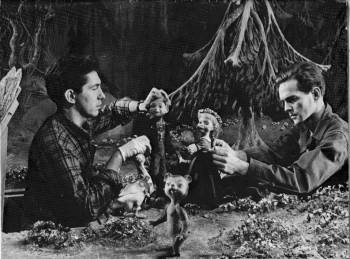 non-animators were hired to animate the puppets. Some of them were master puppeteers (e.g. Don Sahlin had already designed and built all the marionettes on Howdy Doody, Kermit Love went on to do some masterful work with Jim Hensen.) The camerman was the extra- ordinary still-photographer, Martin Munkasci.
non-animators were hired to animate the puppets. Some of them were master puppeteers (e.g. Don Sahlin had already designed and built all the marionettes on Howdy Doody, Kermit Love went on to do some masterful work with Jim Hensen.) The camerman was the extra- ordinary still-photographer, Martin Munkasci.
Of course, all of these people had to learn how to do animation on-the-job.
Don Sahlin and Joe Horstman animating Hansel & Gretel in the woods.
This photo gives a good indication of the scale of the production.
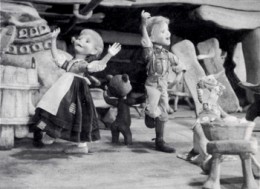
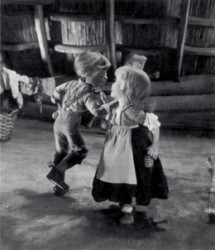
Hansel and Gretel dance inside their cottage waiting for their parents to return.
Aside from it being a first feature for Myerberg, it was also the first time opera was the basis for an animated film. All of the dialogue is sung in an English translation of the Humperdink opera. They utilized some great opera stars such as Anna Russell for the voices. That, in itself, gives the animated feature a peculiar feel.
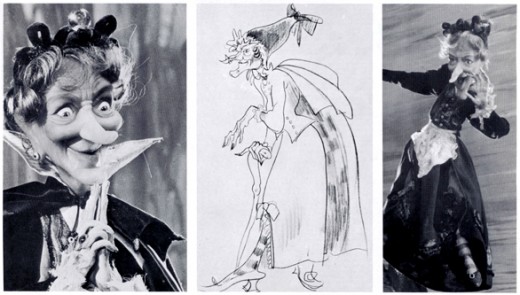
The puppet & production sketch of the evil witch, Rosina Rubylips. The character is voiced by opera star, Anna Russell.
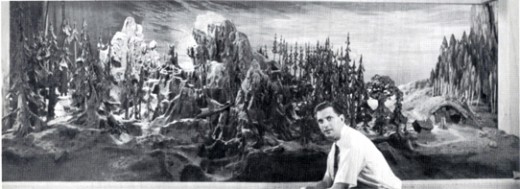
Scenic Designer, Evalds Dajevskis in front of one of his many sets.
Animating the descent of the angels from their fairy kingdom. Pictured are (counterclockwise): Danny Diamond, Kermit Love, Joe Horstman, Sky Highchief, Teddy Shepard and, outside of the circle (with arms crossed) Roger Caras.
It looks to be a relatively large group of animators gathered in and around the very detailed, gingerbread set.
You can see how large the sets and puppets are in this photograph. The animators used electromagnets in the feet of the puppets to keep them anchored to the table. By turning off the switches they were able to move the puppets from the spot where they stood.
The elaborate puppets were created by Jim Summers. He designed armatures for the puppets which had a number of little switches. By pressing on the switch for the leg, for example, you would release the leg and could then move it. By releasing the pressure on the switch, the leg would lock in position.
The director of the film, John Paul, was a British actor directing his first and last animated film.
Comic Art 05 Jun 2006 07:20 am
Barnaby & Mr. O’Malley
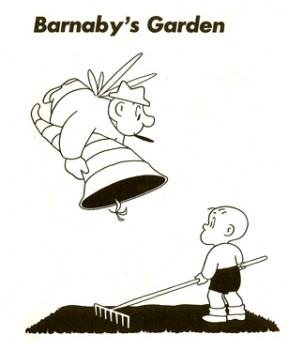 Crockett Johnson, whose most famous books are the Harold and The Purple Crayon series, drew a comic strip from 1942 through 1952 called Barnaby and Mr. O’Malley.
Crockett Johnson, whose most famous books are the Harold and The Purple Crayon series, drew a comic strip from 1942 through 1952 called Barnaby and Mr. O’Malley.
Barnaby was a child, who looked very similar both to Harold and to the child in Johnson’s other hit book, Carrot Seed. Mr. O’Malley was a cigar-smoking guardian angel who often brought more trouble for Barnaby than help.
Barnaby’s parents refused to accept Mr. O’Malley’s presence even when he stood in front of them. It took Barnaby’s growing up to bring an end to O’Malley. After age 6, Barnaby wasn’t allowed to see his friend anymore, thus ending the relationship and the strip.
Crockett Johnson tried updating and revising the stories in the 60′s, but the once successful comic strip wouldn’t ignite again.
This is not a strip for everyone. It’s wordy and seemingly “old fashioned.” There’s a calm to Johnson’s style and a wry sense of humor that I love. I’ve done an animated version of Carrot Seed for HBO and did a small bit of “consulting” work on their series of Harold & The Purple Crayon produced in LA at SONY. There’s a lot of room in his style for adaptation to animation, and I could easily imagine an animated version of this strip.
Here are the first few pages of it.
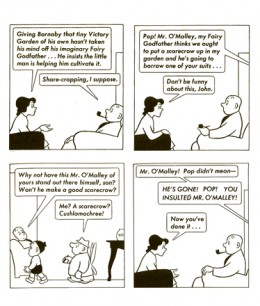
(Click on any image to enlarge.)
Daily post 04 Jun 2006 08:44 am
Pint-sized PIXAR
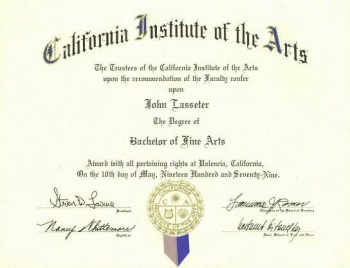 - On Wednesday, June 7, 6:30; repeated Saturday, June 24, 2:00 the Museum of Modern Art is presenting a program of student films by the PIXAR artists who went to CalArts.
- On Wednesday, June 7, 6:30; repeated Saturday, June 24, 2:00 the Museum of Modern Art is presenting a program of student films by the PIXAR artists who went to CalArts.
As part of its program celebrating the works of CalArts, MOMA has com-
piled this program of early works by the likes of John Lasseter, Joe Ranft et. al.
(faked degree for John Lasseter)
School of Pixar
This program features rarely screened CalArts student films by a veritable who’s who of Pixar talent. Program includes:
Winter. 1988. Pete Doctor. 2 min.
Next Door. Pete Doctor. 1990. 3 min.
A Birthday. Brenda Chapman. 1987. 3 min.
A Jim Reardon Film. Jim Reardon. 1986. 4 min.
Tarzan. Mark Andrews. 1993. 3 min.
A Date with Suzie. Max Brace. 1995. 2 min.
Solitaire’s Sanctuary. Karen Kiser. 1985. 6 min.
Nitemare. John Lasseter. 1979. 4 min.
The Lady and the Lamp. John Lasseter. 1979. 4 min.
Good Humor. Joe Ranft. 1979. 3 min.
Man, Monkey, Marshmallow. Matt Majers and Jon Fancher. 1999. 2 min.
smoke…. Bobby Podesta. 1997. 4 min.
Blind Spot. Doug Sweetland. 1993. 3 min.
Legend of Shaolin. Mike Wu. 1994. 2 min.
Train Crazy. Daniel Holland. 2003. 3 min.
Extra Crispy. Mark Walsh. 1997. 4 min.
A Story. Andrew Stanton. 1987. 4 min.
Sis. Ken Bruce. 1986. 5 min.
For the Birds. Ralph Eggleston. 2000. 3 min.
Program 63 min., plus one five-minute intermission.
